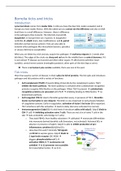Summary
Summary Advanced Medical Microbiology - Test 4 (Bacterial/parasite part)
- Course
- Institution
This is a small summary for the course Advanced Medical Microbiology from the master Biomedical Sciences at the UvA. It includes all the information you need for the first test of this course including lectures from Joppe Hovius, Abijeet Nayak, Esther de Jong, Bas Zaat, Constance Schultz, Aldert Ba...
[Show more]







